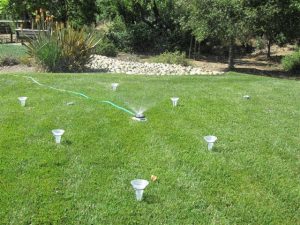Wear Blue for Smart Irrigation Month
The temperature is heating up. After our long, cool, wet spring vegetable gardens and lawns need more water. July is Smart Irrigation Month—for good reason. July is the month when the evaporation rate is highest in the foothills and the month when our plants typically use the most water. The Irrigation Association uses the phrase “saved water is money in the bank” to draw attention to the need to water our landscapes and gardens, our golf courses and shopping center plantings more efficiently.
Celebrate “Smart Irrigation Month” by using some of the watering tips from the University of California Integrated Pest Management program:
- Avoid planting turf species that require frequent watering, such as bluegrass or ryegrass. Try one of the new strains of buffalo grass that can be watered as little as twice a month.
- Water only when your lawn needs water. Water requirements vary according to turf species, location, and month of the year.
- Deeper, less frequent watering is best for most lawns. Water only two or three times per week.
- Urban Drool is Not Cool. Watch your sprinklers to be sure they’re not producing run-off. Adjust the direction of the sprinkler heads; replace broken heads and leaking valves.
- Cut back on fertilizer. Are you growing a grass “crop”? Or do you simply want a reasonably healthy lawn to provide some cooling play space? The more you fertilize, the more water your plants require.
- Many nonflowering trees and shrubs never require fertilizer. Only fertilize when necessary. Slow growth can be a benefit.
- And speaking of trees, never wet the trunk of a tree when irrigating. Water deeply around the dripline. Most established trees and shrubs only need once-a-month watering.
- Water early in the morning before sunlight increases evaporation and before breezes blow your precious water away.
- Mulch, mulch, mulch, mulch! A layer of mulch on the ground reduces evaporation, conserves water, stabilizes soil temperature and crowds out weeds.
- Plant thickly. There’s a reason Native Americans planted the three sisters of corn, beans and squash. Those large squash leaves shade the soil, conserving precious water and reducing evaporation.
- Improve watering efficiency and distribution by using drip irrigation and soaker hoses to take water only where it’s needed.
For more information about irrigating and maintaining a healthy lawn, go to www.ipm.ucdavis.edu and click on “UC Guide to Healthy Lawns.” For more information about water, go to www.tuolumneutilities.com Or call the master gardener hotline at 533-5912.
Rebecca Miller-Cripps is a University of California Cooperative Extension Master Gardener of Tuolumne County.
UCCE Master Gardeners of Tuolumne and Calaveras Counties can answer home gardening questions. Call 209-533-5912. To fill out our easy-to-use problem questionnaire go here. Check out our website here. You can also find us on Facebook.

